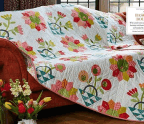

– Lin Clements
THREE-DIMENSIONAL EFFECTS
Creating three-dimensional effects within the constraints of a two-dimensional media, such as painting or fabric patchwork, is an interesting problem, but one that’s well worth exploring. For this month’s Essential Guide, I am looking at which elements are needed to create 3D effects in fabric. Fig 1 shows some examples, most of which I’ve given names for identification purposes. You may recognise Design 6, which is the well-known Tumbling Blocks design (we looked at it way back in issue 3 when we covered set-in seams). In this article, we will first look at some of the properties that help to create a 3D appearance, properties such as linear perspective, colour and value, and diminishing scales. Whether it’s in painted art or fabric art, the same principles apply, although patchwork can be more restrictive depending on the techniques we use. Here, I’m going to supply instructions for making some of the samples shown in this article so you can create some work of your own. I’ve chosen designs that create all-over tessellating patterns, which we looked at in issue 71, but for the patterns in this article the emphasis is on creating the illusion of depth. I’ve made the samples using a range of techniques, so you can learn new skills or practise those you may only be slightly familiar with.







CREATING 3D ILLUSIONS
Various qualities create a 3D illusion within






